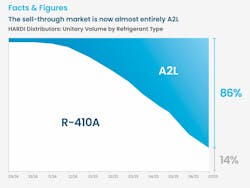AHR Releases 2026 Trend Report
The following excerpts were gathered from the 63-page AHR 2026 Trend Report, published November 18, 2025.
INTRODUCTION
HVACR is a uniquely dynamic industry, uniting professionals from cross-disciplinary sectors. While our day-to-day roles may differ, we share common goals that drive progress with the objective to advance HVACR. The Industry Trend Report reflects this diversity, offering insights that bridge perspectives and spark meaningful conversations regarding the state of this industry ahead of our February 2026 event in Las Vegas.
Insightful contributions from our endorsing associations alongside perspectives from the various voices that make up the industry make for a unique compilation that captures the breadth of roles within HVACR and highlights key topics shaping today’s discussions. We are grateful to all who participated—your perspectives are essential to understanding both the challenges and opportunities facing our industry.
As we prepare to meet in person, we recognize that aligning our varied approaches is critical to continued growth and shared success—a commitment that grows more important each year. Find more information, visit us at ahrexpo.com.
THE CURRENT STATE OF HVACR
STEVE YUREK, President & CEO, AHRI
The HVACR and water heating industry has the solutions and experience to help countries and regions to achieve their sustainability goals. This year’s watchword is affordability, as policy makers around the world strive to ensure progress toward their energy and environmental goals while ensuring continued consumer access to economical, efficient, reliable equipment.
Completing the global transition toward next-generation refrigerants remains high on our industry’s priority list. Our continued efforts to expand our global reach – we recently opened our 6th global office, in Singapore – will help policymakers there and in many other parts of the world use our standards and certification programs as paths to achieve sustainability goals. Other pressing issues include continued state efforts to regulate PFAS and plastics and packaging, and expand extended producer responsibility efforts.
As the tax credits and rebates for highly efficient equipment wind down in the United States as a result of the recent tax bill, as tariff activities increase, manufacturers will be seeking additional ways to continue to provide essential affordable, reliable, efficient products to their customers.
Our industry is navigating a changed political landscape that presents both challenges and opportunities. Completion of the refrigerant transition is a challenge we are confident we can meet, while reform of the Energy Policy and Conservation Act (EPCA) has its best chance in a long while, with a relatively sympathetic Congress and White House.
Keeping essential heating, cooling, water heating, and commercial refrigeration equipment affordable in light of eliminated tax credits and increased tariffs is probably the most pressing issue facing our manufacturers.
BILL McQUADE, 2025-26 President, ASHRAE
The HVACR industry is experiencing a period of rapid transformation. The focus is no longer solely on efficiency or cost savings. It is equally about creating indoor spaces that actively support health, comfort, and productivity. The technologies and solutions driving our sector forward are reshaping expectations for how buildings should perform for both people and the planet.
In the short term, the HVACR industry is adapting to rising expectations for energy efficiency, carbon reduction and improved resilience of building systems. This includes addressing refrigerant transitions, electrification and smarter controls. In the long term, the industry is moving toward integrated building performance, where heating, cooling, water and power systems work seamlessly together. This change requires collaboration across disciplines and reinforces the role of HVACR professionals as central to the future of building design and operation.
The coming year presents tremendous opportunities to expand the adoption of IEQ monitoring and control technologies, further develop building decarbonization strategies, and strengthen the industry’s role in educating building owners, policymakers and the public about the value of healthy, sustainable indoor environments. These opportunities highlight how HVACR professionals can lead the next chapter of building innovation.
Looking ahead, the industry must overcome challenges related to the cost and adoption of health-centered technologies, the alignment of building codes and standards with emerging IEQ expectations, and the ongoing need to equip the workforce with the skills to manage increasingly integrated and intelligent systems. These challenges underscore the importance of collaboration, investment and continued education.
The innovations most likely to impact the future of HVAC&R include intelligent indoor air quality systems that adapt in real time to occupancy and pollutant levels, AI-driven optimization for predictive system performance, heat recovery from high-intensity facilities like data centers, and integrated solutions that manage both air and water quality. These advances promise to expand the role of HVACR professionals in supporting healthier, more sustainable communities.
GREG WALKER, CEO, ASHB (formerly CABA)
The HVACR industry is at a pivotal point, caught between urgent climate commitments and a wave of technological innovation. From AI and automation to electrification and IAQ, the pressure is on to deliver smarter, cleaner, and more resilient systems.
There’s been a noticeable acceleration in how the industry approaches digital transformation and decarbonization. More companies are moving beyond pilot projects and scaling smart building strategies across entire portfolios. AI integration has also matured, shifting from hype to practical applications like predictive maintenance, energy optimization, and system diagnostics. Additionally, customer demand for open, interoperable systems has grown significantly, putting pressure on vendors to prioritize flexibility and integration. Finally, the workforce conversation has expanded beyond recruitment to include upskilling existing talent in data analytics, cybersecurity, and systems thinking.
Opportunities lie in enabling smarter retrofits, particularly in existing commercial buildings. Leveraging cloud-based platforms, edge devices, and integrated analytics can help legacy systems catch up without a full rip-and-replace. Additionally, federal and state-level incentive programs continue to fuel investment in energy efficiency and indoor air quality improvements.
Cybersecurity is becoming a major concern as more HVAC systems connect to the cloud. We’re closely watching how manufacturers are responding with more secure-by-design products. Supply chain resiliency and equipment standardization are also ongoing challenges, especially as the industry pushes toward electrification and low-GWP.
TALBOT GEE, CEO, HARDI
2026 will test the industry’s ability to adapt as much as it will reward those who’ve learned from the past two years. The refrigerant shortages of 2025 exposed the cost of weak forecasting and breakdowns in communication across the supply chain, but they also sharpened the industry’s awareness of what coordinated planning requires.
The way distributors manage pricing impacts from tariffs will reveal — and strengthen — their value as partners to their customers. It will also be essential that we continue stay the course set by the AIM Act, even as uncertainty surrounding the Technology Transition Rule creates some unease. HARDI remains focused on ensuring distributors
have the insight and tools to meet these challenges head-on.
Recent trends from HARDI’s Unitary Market Program indicate that the transition to A2L products is nearing completion. As of July 2025, A2L refrigerants accounted for 86% of unitary sell-through volume, with R-410A representing just 14%. This marks a significant milestone for the industry, reflecting both the adaptability of distributors and manufacturers and the growing alignment with the goals of the AIM Act.
One of the most immediate challenges we’re watching is the sharp decline in air conditioning demand during the latter half of 2025. Weak sell-through has led to elevated inventory levels, putting added pressure on margins. As a result, maintaining profitability in the near term will depend heavily on disciplined cost management and careful inventory control. The coming year will test the industry’s ability to balance operational efficiency with readiness for eventual demand recovery.
JOHN MULLEN, Director of Technical Services and Research, IAPMO
The heating and cooling industry is changing faster than it ever has. The scope is expanding, and new methods are being tested and verified every day. Keep your ear to the ground for the innovative ways plumbers and fitters are reshaping the nation’s energy landscape.
As we head into 2026, AI-driven controls, advanced hydronic systems, and Thermal Energy Networks are moving from concept to core infrastructure. The momentum is incredible, but so is the responsibility. Meeting climate goals, improving efficiency, and training a new generation of skilled workers to keep pace. Water remains our most overlooked energy asset, and when used as a tool for thermal energy transfer, it creates systems that are cleaner, more resilient, and more cost-effective for communities everywhere.
Modern methodologies like geothermal systems, thermal energy networks, integrated AI controls, and advanced hydronic applications are no longer ‘special projects’ they’re becoming standard expectations. That shift demands more than just technical know how; it requires a rethinking of how we train, mentor, and certify the next generation.
Through organizations like the Radiant Professionals Alliance (RPA), we’re creating pathways for tradespeople to get hands-on with these emerging systems while learning directly from industry veterans. Through IAPMO, the RPA’s collaborative approach is bringing together contractors, engineers, manufacturers, and educators to ensure that knowledge transfer happens at every level, from the classroom to the job site. The industry’s future will be defined by how well we scale this education.
The future of our industry is being written right now and it’s a collaborative story. Heating, cooling, and plumbing are converging into a single, interconnected hybrid, where water and energy are managed with precision and shared across systems; even entire communities. The leaders in this movement are those willing to break down traditional trade boundaries, share knowledge, and think bigger than their own niche.
This movement is about re-imagining how the built environment works as a whole. By aligning contractors, engineers, utilities, and policymakers toward shared goals, we can deliver systems that are highly adaptable to the challenges of the decades ahead.
#####
For the complete AHR 2026 Trend Report, go to www.ahrexpo.com/2026-trend-report.






